simpeg.electromagnetics.viscous_remanent_magnetization.Simulation3DLinear#
- class simpeg.electromagnetics.viscous_remanent_magnetization.Simulation3DLinear(mesh, xi=None, xiMap=None, **kwargs)[source]#
Bases:
BaseVRMSimulationAttributes
The geometric sensitivity matrix for the linear VRM problem.
The characteristic decay matrix for the VRM problem.
Topography active cells.
A list of solver objects to clean when the model is updated
SimPEG
Counterobject to store iterations and run-times.HasModel.deleteTheseOnModelUpdate has been deprecated.
active_cells.indActive has been deprecated.
Mesh for the integral VRM simulations.
The inversion model.
True if a model is necessary
Sensitivity refinement radii from sources.
The number of refinement distances.
Path to directory where sensitivity file is stored.
The VRM survey.
Verbose progress printout.
Amalgamated viscous remanent magnetization parameter xi = dchi/ln(tau2/tau1) physical property model.
Derivative of Amalgamated Viscous Remanent Magnetization Parameter xi = dchi/ln(tau2/tau1) wrt the model.
Mapping of the inversion model to Amalgamated Viscous Remanent Magnetization Parameter xi = dchi/ln(tau2/tau1).
Methods
Jtvec(m, v[, f])Compute (Pd*T*A*dxidm)^T * v
Jtvec_approx(m, v[, f])Approximation of the Jacobian transpose times a vector for the model provided.
Jvec(m, v[, f])Compute Pd*T*A*dxidm*v
Jvec_approx(m, v[, f])Approximation of the Jacobian times a vector for the model provided.
fields(m)Computes the fields d = T*A*m
make_synthetic_data(m[, relative_error, ...])Make synthetic data for the model and Gaussian noise provided.
residual(m, dobs[, f])The data residual.
dpred
Galleries and Tutorials using simpeg.electromagnetics.viscous_remanent_magnetization.Simulation3DLinear#

Predict Response from a Conductive and Magnetically Viscous Earth

Method of Equivalent Sources for Removing VRM Responses

Response from a Homogeneous Layer for Different Waveforms

